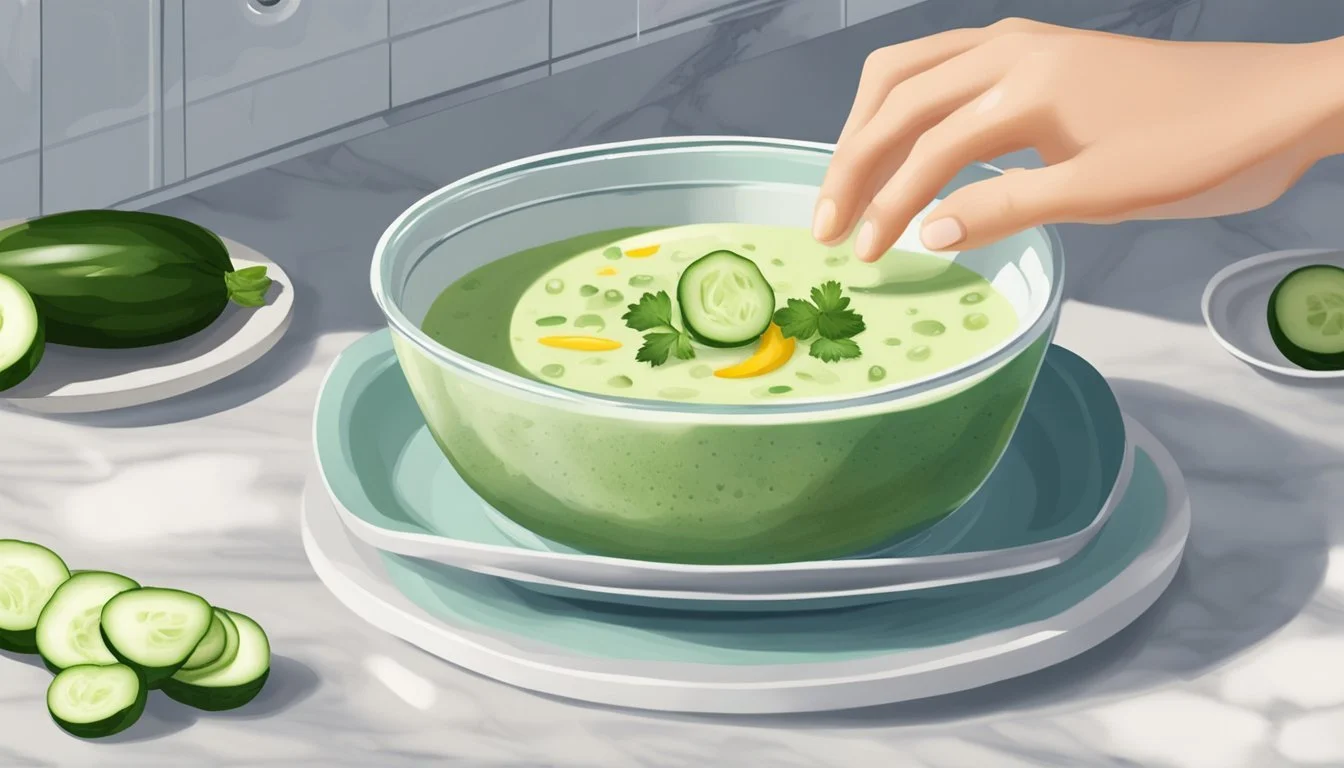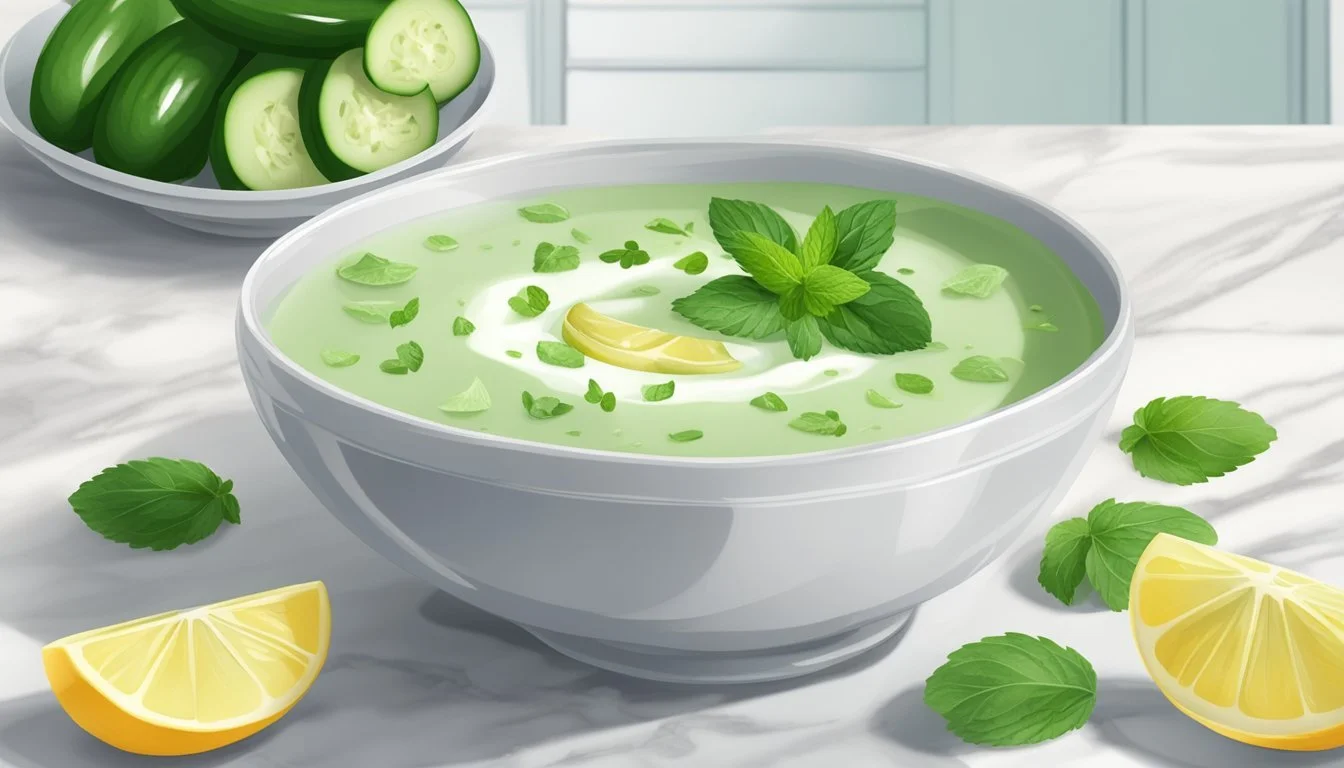Best Way to Reheat Chilled Cucumber Soup While Maintaining Its Fresh Taste
Chilled cucumber soup offers a refreshing and light option, especially during warm weather or as a palate-cleansing course. However, once refrigerated, the key to enjoying this delicacy lies in how it is reheated. Maintaining the coolness and flavor of cucumber soup requires gentle handling to preserve the integrity of its ingredients.
Reheating cucumber soup to the perfect temperature is an art that ensures the balance of its delicate flavors remains intact. It's a process that emphasizes retaining the soup's original cool temperature while avoiding any technique that might compromise its fresh, crisp taste. This comes down to understanding the subtle complexities of the soup's components and the best methods to heat it without escalating its temperature beyond the desired chilliness.
Understanding Cucumber Soup
In exploring cucumber soup, one should consider the refreshing quality of its key ingredients, the preparation method that leads to its chilled delicacy, and the health benefits it brings to the table.
Identifying Key Ingredients
Cucumber soup relies on fresh cucumbers as its core component. They are often blended with ingredients like:
Yogurt or sour cream for creaminess.
Herbs such as dill or basil to enhance flavor.
Garlic and onions for a savory note.
Lemon juice or vinegar to add a touch of acidity.
These ingredients work in concert to create a soup that is not only refreshing but also full of layered flavors.
The Basics of Chilled Soup
Chilled soups (What wine goes well with soups?) are served cold and are particularly popular in warmer climates or during summer months. Cucumber soup entails pureeing the main ingredients and then chilling the mixture for several hours. This process allows the flavors to meld and the soup to attain a refreshing coolness, making it a perfect antidote to heat.
Health Benefits and Nutritional Info
Cucumber soup is low in calories yet rich in nutrients, such as:
Vitamin K: important for bone health.
Potassium: aids in blood pressure regulation.
Fiber: beneficial for digestive health.
The soup's high water content also makes it hydrating, which is essential for maintaining good health during hot weather.
Preparation and Storage Tips
Maintaining the fresh taste and coolness of chilled cucumber soup requires proper storage techniques and understanding how to prep the soup for later consumption.
Proper Storage for Freshness
To ensure the freshness of cucumber soup, one should refrigerate it within two hours of preparation. It's imperative to use airtight containers to shield the soup from absorbing other flavors from the refrigerator and to prevent bacterial growth. The ideal storage temperature is below 40°F. The prep time invested in chilling soup should not be undermined by poor storage practices which can quickly degrade quality.
Freezer-Friendly Soup Strategies
When planning to store cucumber soup in the freezer, a proactive approach is to cool the soup rapidly using an ice water bath before freezing. Freezer-safe containers or bags help prevent freezer burn and preserve texture. Here's a series of steps to freeze cucumber soup correctly:
Cool the soup to room temperature.
Pour into a freezer-safe container, leaving some room for expansion.
Label containers with the date and contents.
Place in the coldest part of the freezer.
For best results, consume frozen soup within 2–3 months.
Optimizing Chilled Soup Consistency
The texture of the soup is paramount, especially when dealing with delicate chilled soups like cucumber. To avoid a grainy texture after thawing, stir the soup well before and after freezing. It’s also beneficial to slowly thaw the soup in the refrigerator to maintain consistency. Avoid refreezing as it can further break down the texture and diminish flavor quality.
Reheating Cucumber Soup
When reheating cucumber soup, maintaining the delicate balance between temperature and flavor is crucial. One must reheate carefully to preserve the cool, fresh taste typical of this type of soup.
Balancing Temperature and Flavor
To reheat cucumber soup while retaining its flavor, a gentle approach is essential. Avoid high heat, as it can cause the soup to lose its characteristic coolness and can negatively impact the flavors. A steady, low temperature is key for even heating without overheating.
Preserving the Soup's Integrity
When considering safety and texture, it’s important to avoid bringing cream-based soups to a full boil, as this can cause separation and a gritty consistency. The integrity of the soup can be preserved by reheating it just until it reaches a suitable temperature for consumption.
Reheating Methods and Techniques:
Microwave: Place the soup in a microwave-safe bowl, and cover with a microwave-safe lid to contain moisture. Heat on medium power for short intervals, stirring between each to promote even heating.
Initial heating: 2 minutes on medium
Subsequent heating: 30-second intervals, stirring in between
Stovetop: Pour the soup into a saucepan and warm over low heat. Stir occasionally to ensure an even reheat. Do not allow the soup to simmer as it may alter the intended texture and coolness.
Temperature control: Low heat
Stirring: Frequent to maintain even temperatures
Enhancing and Serving
When reheating chilled cucumber soup, it is essential to consider garnishes and accompaniments to enhance the cool, refreshing flavors. The choice of garnishes can elevate the flavor profile, while selecting the right dishes to pair with the soup can create a harmonious meal.
Elevating with the Right Garnishes
Garnishes not only add visual appeal to cucumber soup but also introduce complementary flavors and textures. Consider the following:
Fresh Herbs: A sprinkle of finely chopped dill or mint offers a burst of freshness.
Yogurt: A dollop of Greek yogurt or sour cream can add creaminess and tang.
Citrus: A light drizzle of lemon juice before serving can brighten the overall taste.
Pairing with Complementary Dishes
Choosing dishes that complement the lightness of cucumber soup can result in a balanced meal:
Cold Appetizers: Such as salads or ceviche.
Sandwiches: A delicate tea sandwich with cucumber or smoked salmon pairs well.
Grilled Seafood: Grilled shrimp or fish can be a protein-rich counterpart that does not overpower the soup.
Serving Suggestions for Different Occasions
Cucumber soup can be presented differently depending on the event:
Formal Dinners: Serve in elegant bowls, garnished with fresh herbs and an artistic swirl of yogurt.
Casual Gatherings: Offer the soup in mugs for easy handling at a buffet or picnic.
Summer Refreshment: Serve in chilled glasses, topped with fresh dill, mint, or lemon zest for a cooling treat.
Recipe Variations and Ideas
Chilled cucumber soup offers a versatile canvas for culinary creativity. In this section, we explore ways to elevate the classic recipe, integrate international inspiration, and adjust for dietary needs while maintaining its distinct coolness and flavor.
Classic and Contemporary Twists
Classic chilled cucumber soup can serve as a refreshing base for numerous contemporary variations. A simple change can transform the delicate flavor: add a swirl of herbed yogurt or substitute traditional dill with mint for a fresh twist. For a more substantial shift, one might consider creating a cucumber gazpacho by incorporating ripe tomatoes and bell peppers, and serving it with a side of rustic bread.
Incorporating Global Flavors
International influences offer a wealth of flavor to the traditional cucumber soup. Mediterranean versions might include a touch of sumac or za'atar, while Asian-inspired recipes could call for a hint of sesame oil and fresh ginger. A Middle Eastern variant may combine yogurt, diced cucumbers, and herbs, along with a sprinkle of crispy shallots or dukkah for texture.
Dietary Adjustments for All
The soup can easily adapt to suit various diets:
Vegan: Use plant-based yogurt and omit any dairy or animal-based ingredients.
Gluten-Free: Ensure that all added ingredients, including garnishes and sides, adhere to gluten-free standards.
Low-Carb: Focus on increasing the herb and spice components, while reducing any high-carb additions like croutons.
Safety and Best Practices
When reheating chilled cucumber soup, safety and flavor preservation are paramount. By carefully following safety guidelines and employing best practices for avoiding cross-contamination, one can ensure a safe and tasteful experience.
Avoiding Cross-Contamination
Cross-contamination can occur when bacteria from different foods mix. To prevent this:
Use separate utensils: Stir and taste the soup with different spoons.
Store correctly: Keep chilled cucumber soup in a clean, airtight container away from raw food.
Understanding Soup Safety Guidelines
Chilled cucumber soup, especially if it's cream-based, requires careful handling to maintain safety and quality.
Temperature control: Ensure the soup is stored below 40°F to inhibit bacterial growth.
Reheating: If the soup has been chilled, reheat it to at least 165°F to ensure it is safe for consumption before cooling it down again.
Conclusion
When reheating chilled cucumber soup, the objective is to preserve its coolness and distinctive flavor, ensuring it remains a delicious starter or lunch option. They should begin by transferring the soup into a suitable container if it is not already in one. They should avoid using high heat as it can alter the soup's texture and taste. Instead, they should opt for gentle, indirect warming techniques. A water bath method, where the soup container is placed in a larger bowl of warm water, can warm the soup slowly while retaining its refreshing temperature.
To maintain the soup's integrity, individuals should frequently stir the soup during the reheating process. This ensures that the temperature distributes evenly, preventing hotspots. The soup should not be overheated; instead, their goal is to bring it to a palatable temperature that aligns with its chilled nature.
They must remember that the key to serving cucumber soup as a satisfying dish lies in its preparation, storage, and cautious reheating. With these measured steps, they can relish their cucumber soup with its flavor and coolness intact, making it a delightful starter or complement to their lunch.






